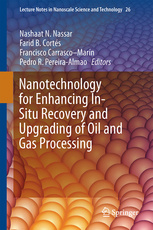Description
Nanoparticles: An Emerging Technology for Oil Production and Processing Applications, 1st ed. 2021
Lecture Notes in Nanoscale Science and Technology Series, Vol. 32
Coordinators: Nassar Nashaat N., Cortés Farid B., Franco Camilo A.
Language: English
Subjects for Nanoparticles: An Emerging Technology for Oil Production...:
Keywords
Application of Nanofluids; Cracking and Gasification of Asphaltenes; Determination of Reservoir Saturations; Environmental Applications of Nanoparticles; Eor/Ior; Formation Damage Remediation; Heavy Oil Upgrading; Nanotechnology in Oil Industry; Recovery Enhancement; Remediation of Oil Spills; Wettability Alteration
518 p. · 15.5x23.5 cm · Paperback
Description
/li>Contents
/li>Biography
/li>Comment
/li>
Dr. Nashaat N. Nassar is a full professor in the Department of Chemical and Petroleum Engineering at the University of Calgary. He leads a large research group focuses on the development and application of naturally-derived nanomaterials in energy and the environment. He established a world-leading, industrially-connected Laboratory for Nanomaterials Research, and he is currently working with several national and international oil and gas companies to commercialize his research. Energy and environment applications are the dominant theme of his research activities to serve the Canadian community. Dr. Nassar’s research program emphasizes on the development of new technologies to improve the sustainability of unconventional hydrocarbon recovery processes and to advance the transition to low carbon energy sources. Dr. Nassar communicated his scientific knowledge through publishing 110 peer-reviewed journal papers, ten book chapters, two books, seven filed USA patents and six invention disclosures, and founded two spin off companies (NanoSoln Inc. and Carbon OxyTech Inc.). He has an h-index of 42 and his work has been cited 5179 times. He has received several prestigious awards and has delivered 50 invited talks in renowned national and international conferences and universities. Not only is he pushing the limits of science and technology in his field, but he does also so in collaboration with national and international top-ranked industrial sponsors, who understand and benefit from his unique approach to solving real world problems. Funding for his research has been through national programs such as NSERC DG, Engage, and Alliance, provincial funding through Alberta Innovates, industry contracts with Cenovus Energy, Seven Generation Energy, Executive Mat Services, and international funding through organizations such as CIATEC-PROFTECH-CONACYT-PEMEX, Mexico; Chevron USA Inc; QEERI in Qatar, and Werner Graupe International. He trained 11 postdoctoral fellows, 12
Translates the findings from research studies in nanoscience and nanotechnology into potential practical applications
Provides an overview of current applications and highlights future prospects and challenges
Includes several examples of environmental applications of nanoparticles
These books may interest you

Petroleum Radiation Processing 232.80 €

Petroleum Radiation Processing 74.82 €


